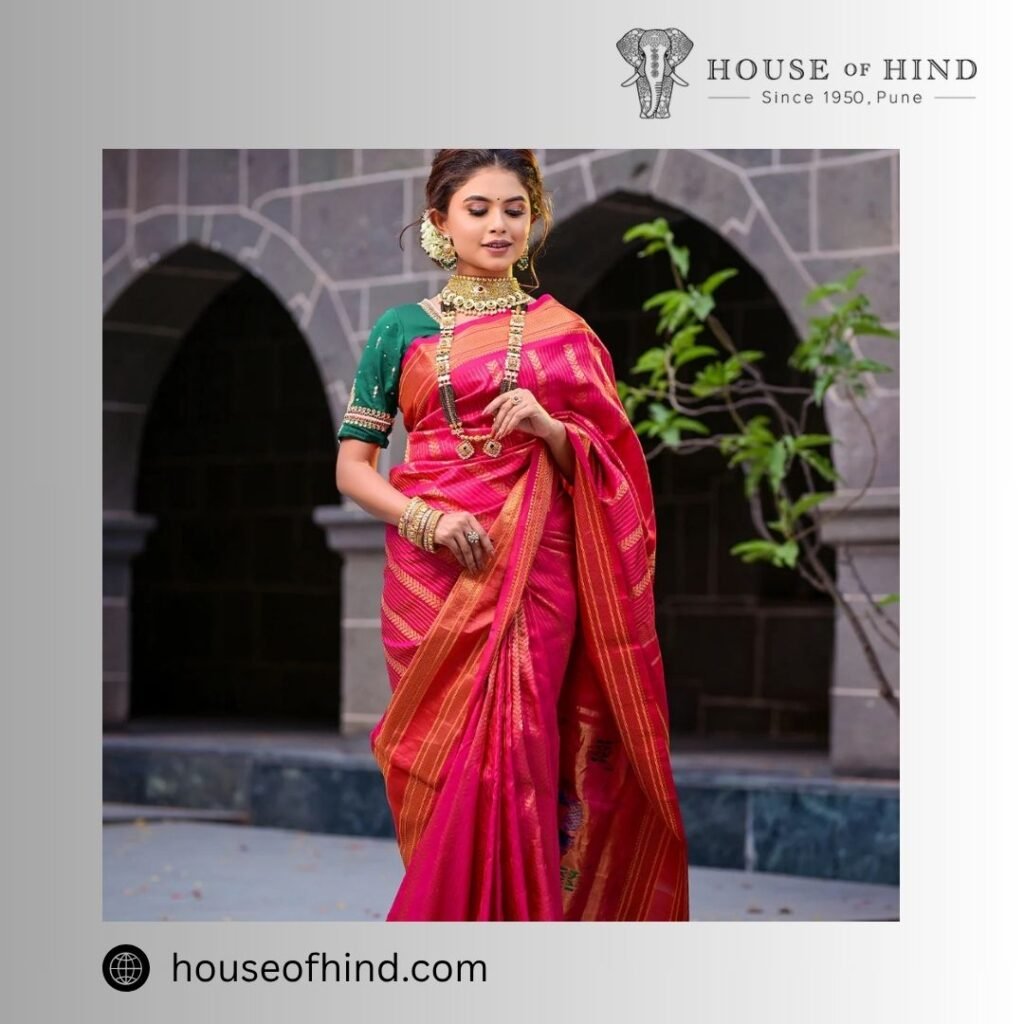A Royal Legacy Woven in Silk and Gold
The Paithani saree stands as one of India’s most exquisite handwoven treasures, tracing its roots back nearly 2,000 years. Known as the “Queen of Sarees,” the Paithani originated in the ancient town of Paithan, Maharashtra — once a flourishing hub of trade and artistry during the Satavahana dynasty.
Synonymous with grace, royalty, and craftsmanship, the Paithani saree was a prized possession of queens and noblewomen. Its hallmark — pure silk body interwoven with gold zari borders and intricate motifs — made it the ultimate symbol of opulence and cultural prestige. Today, even as the world embraces modernity, the Paithani continues to represent India’s timeless artistry and cultural continuity.
From Ancient Kingdoms to Modern Couture
The story of the Paithani saree begins in Paithan, an ancient city located along the banks of the Godavari River. During the Satavahana period (around 200 BCE – 200 CE), Paithan was a bustling center of silk and zari weaving. The city’s artisans were famed for their mastery in handloom weaving, producing fine silk textiles that were traded across India and even exported to Rome.
As dynasties changed — from the Satavahanas to the Yadavas, Mughals, Peshwas, and Marathas — each era added new motifs, techniques, and influences to the craft. The Maratha queens, especially Queen Ahilyabai Holkar, are credited with reviving and popularizing the Paithani saree as a symbol of royal attire and cultural identity.
The Art of Weaving a Paithani
Each authentic Paithani saree is handwoven using the finest mulberry silk and genuine gold zari threads. The weaving process is incredibly intricate — it can take anywhere from 15 days to 6 months to complete a single saree, depending on the design complexity.
The hallmark of a genuine Paithani lies in its obverse and reverse symmetry — both sides of the pallu look identical, a feat only achievable by highly skilled weavers. Traditional designs such as peacocks, parrots, and lotuses adorn the pallu, symbolizing prosperity, purity, and beauty.
The vibrant colors, achieved through natural dyes, give each Paithani its signature richness — from deep magentas and emeralds to bright yellows and indigos.
Cultural Significance Through the Ages
For centuries, the Paithani has been more than just attire — it’s a cultural heirloom passed down through generations. In Maharashtra, it’s considered a bridal must-have, symbolizing wealth, grace, and auspicious beginnings. It is also worn during key ceremonies and festivals like Diwali, Gudi Padwa, and traditional weddings.
During the Peshwa rule, Paithanis were considered so valuable that they were often exchanged as gifts among royal families. Even today, the saree is often part of a bride’s trousseau, representing both heritage and elegance.
Paithani Saree Online – Preserving Heritage in the Digital Age
In today’s fast-paced world, the demand for authentic Indian handlooms has found a new home online. The ability to buy Paithani saree online has not only made this centuries-old craft accessible globally but has also provided sustainable livelihoods to artisans.
Platforms like House of Hind are leading this transformation by bridging the gap between traditional craftsmanship and modern accessibility. Their curated collection showcases the beauty of authentic Paithanis while supporting the weavers who keep this heritage alive. Every saree available online is certified, handwoven, and crafted using ethical, time-honored techniques.
Evolution of Design and Motifs
Over time, the Paithani has evolved to reflect the changing tastes of generations while preserving its traditional essence.
Traditional Motifs:
- Bangdi Mor (Peacock in Bangle Design): Symbolizing grace and grandeur.
- Asawali (Vine and Flower): Representing growth and beauty.
- Muniya (Parrot): A sign of happiness and good fortune.
- Lotus and Narali (Coconut): Associated with spirituality and purity.
Modern Adaptations:
In recent years, designers have reimagined the Paithani with pastel tones, lighter silks, and contemporary motifs, appealing to a younger audience while staying true to its roots. From minimalist zari borders to ombre weaves, today’s Paithani saree is a seamless blend of tradition and trend.
From Loom to Legacy
Each Paithani saree is a labor of love — taking months of dedicated craftsmanship. The process begins with silk reeling, followed by dyeing, zari preparation, and finally, the meticulous weaving. Every weave represents generations of inherited knowledge, precision, and passion.
House of Hind works closely with artisan communities to ensure that this craftsmanship is preserved for future generations. Their mission is not only to sell sarees but to sustain an art form that defines India’s textile heritage.
Why Every Woman Should Own a Paithani Saree
Owning a Paithani is like owning a piece of Indian history. It transcends fashion trends, standing as a timeless garment that can be worn, cherished, and passed down. Whether it’s for a wedding, festive celebration, or cultural event, the Paithani saree brings with it a sense of pride and belonging that connects every woman to India’s royal legacy.
Pair it with traditional jewelry, soft makeup, and confidence — and you’ll carry the regal charm of centuries in a single drape.
Buy Paithani Saree – Celebrate the Tradition That Lives Forever
As modernity embraces tradition, the Paithani saree continues to shine as a symbol of enduring Indian artistry. If you wish to experience the allure of genuine craftsmanship, explore and Buy Paithani saree at House of Hind.
Each saree is a masterpiece — handwoven with precision, authenticity, and love — designed not just to be worn, but to be treasured for a lifetime. With every drape, you don’t just wear history — you become a part of it.







